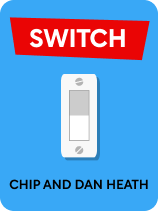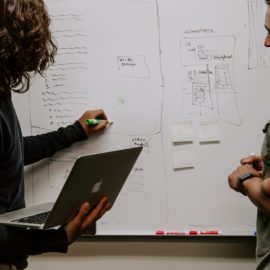

This article is an excerpt from the Shortform book guide to "Switch" by Chip and Dan Heath. Shortform has the world's best summaries and analyses of books you should be reading.
Like this article? Sign up for a free trial here .
What are action triggers? How can they help with habit formation?
We set up action triggers to prompt particular actions. For example, when you’re drinking your first cup of tea in the morning (trigger), you create your goals for the day (action). Setting up action triggers to prompt desirable behavior is foundational in forming habits.
Keep reading to learn how to use action triggers to facilitate habit formation.
Create Change-Supporting Habits
It’s not always possible to change your environment to fit your change—your cubicle at work might not have the space for a change-supporting revamp. In these cases, work on rebuilding your habits so that they trigger good behaviors instead.
When you make a habit of your desired behaviors, they become autopilot behaviors that you naturally fall back on to conserve rational energy—over time, they stop being a conscious effort and become an effortless reflex.
Action Triggers and Preloaded Responses
At the base of good habit-building are “action triggers.” These are the triggers we set up to prompt a certain action.
- For example, “When I leave work (trigger), I’ll go to the gym (action)” or, “Once I finish dinner (trigger), I’ll start my homework (action).
Using action triggers to prompt certain behaviors works well, but only under certain circumstances. They’re effective for actions you know you need to do, such as doing homework or finishing a project. On the other hand, they usually don’t work with things you don’t want to do—especially if they don’t need to be done.
- “After work, I’ll put together that IKEA bedroom set” isn’t an effective action trigger. Not only do you not want to do the action, but there also won’t be any serious consequences if you don’t.
However, when you combine action triggers with preloaded responses, you create powerful habits. A preloaded response is a reaction that you’ve thought through and practiced until it’s your reflexive response to a situation that calls for it.
- For example, you decide, “When I procrastinate on homework by scrolling through Instagram, I’ll block all social media for two hours.” You practice by always blocking social media for a few minutes before scrolling. Soon, it becomes a reflexive response.
Pairing action triggers with preloaded responses is effective because it prevents you from getting lost in possible solutions or pulled off track by your emotional side. You don’t need to decide how to act in response to an action trigger—you’ve practiced so many times, you already know what to do. You don’t needlessly tire out your rational side with deliberation and can focus your energy on getting the right thing done. In fact, research shows that using preloaded responses can increase your chances of achieving goals from 22% to 62%.
How to Create a Preloaded Response
While creating preloaded responses, it’s helpful to reframe your thoughts from “What is the right thing to do?” to “How can I get the right thing done when my action trigger happens?”
Your action triggers need to be specific and visible—otherwise, they won’t give a strong enough cue to trigger your preloaded response. For example, imagine that you’re trying to cut down on drinking. First, remind yourself what the right thing to do is—avoiding situations that will tempt you to drink. You identify the situations that usually trigger you to drink, and create preloaded responses to them.
- “When the waiter asks me what I would like to drink, I’ll say seltzer.”
- “When I’m walking home after work, I’ll take the long way around the block to avoid walking in front of the bar.”
These action triggers—“when the waiter asks me what I would like to drink,” and “when I’m walking home after work”—are specific enough to prompt the good behavior you practiced. On the other hand, if you’d chosen a vague action trigger like, “I’ll drink seltzer instead of wine when I go out,” you could easily rationalize an anti-change behavior: “We’re at dinner, which isn’t really going out. Just one glass of wine will be fine.”
(Shortform note: Read our summary of The Power of Moments for more ways that pre-loaded responses can help you do the right thing.)
How Leaders Can Help Teams Build Habits
Teaching others how to build a habit is an essential leadership tool. When you help your team cultivate change-supporting habits, they naturally move toward your goals without needing continuous oversight. A good leader understands that change resistance is usually situational, not personal. People aren’t resisting change out of spite—they just don’t know how to make the change stick.
Help your team cultivate change-supporting habits that a) serve your mission and b) are easy to adopt.
Tool #1: Action Triggers
You might help your team members decide which actions should trigger which responses—and remind them until the action and response become an established habit.
- For example, you want team members to send out project status reports each Friday, but by the end of the week, everyone is too busy or overwhelmed to remember. “Remember to send your status report” is too vague—there’s no specific action to trigger the desired response. Instead, you make a specific action trigger: “On Fridays, while you have your first cup of coffee at your desk, type up your status report and send it out.”
For future changes, have team members create their own action triggers—ask them when and where they’ll perform change-supporting behaviors.
Tool #2: Checklists
Checklists are a useful tool in distracting or complex environments where people may forget change-supporting behaviors. Checklists force people to remember and perform all the behaviors necessary to change.
- For example, a Michigan hospital that wanted to reduce their ICU’s infections from IV insertion created a checklist for the process and required all doctors to use it. Everything on the list was information that the doctors already knew—the handwashing process, the steps of disinfecting, and so on—but could easily be forgotten in the distracting context of their work. Over 18 months, the ICU nearly eliminated their IV infections, saving 1,500 lives.
(Shortform note: Read our summary of The Checklist Manifesto for more tips on controlling complex situations and avoiding mistakes with checklists.)

———End of Preview———
Like what you just read? Read the rest of the world's best book summary and analysis of Chip and Dan Heath's "Switch" at Shortform .
Here's what you'll find in our full Switch summary :
- Why some changes succeed while others fail
- Actionable advice for creating changes that not only succeed but stick
- The three essential elements for successful change





